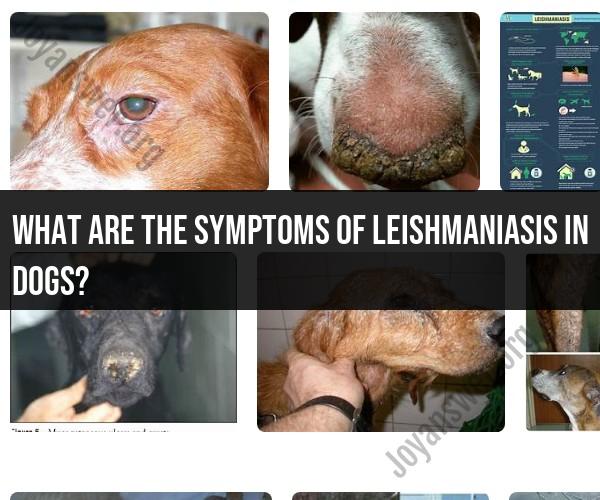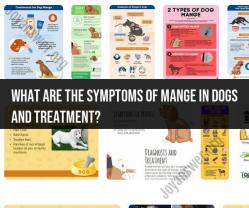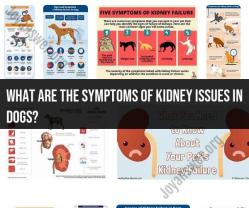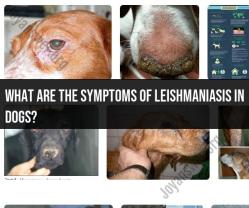What are the symptoms of leishmaniasis in dogs?
Leishmaniasis is a parasitic disease caused by protozoa of the Leishmania genus. It can affect dogs and humans and is transmitted through the bite of infected sandflies. The symptoms of leishmaniasis in dogs can vary widely, and some infected dogs may not show any signs of illness. However, when symptoms do occur, they can include:
Skin Lesions: Skin problems are often the most noticeable signs of leishmaniasis in dogs. These can include:
- Hair loss (alopecia)
- Scaly, dry, or crusty skin
- Skin ulcers or sores, especially around the head, ears, and limbs
- Nodules or raised lumps on the skin
Eye Issues: Leishmaniasis can affect the eyes and cause symptoms such as:
- Conjunctivitis (inflammation of the conjunctiva)
- Eye discharge
- Eye ulcers or lesions
- Vision problems
Nasal and Oral Symptoms: Dogs with leishmaniasis may exhibit symptoms in the nose and mouth, including:
- Nosebleeds (epistaxis)
- Nasal discharge
- Difficulty swallowing or eating
- Oral ulcers or sores
Lethargy and Weakness: Infected dogs may become lethargic and weak, with reduced energy levels.
Weight Loss: Unexplained weight loss can be a symptom of leishmaniasis.
Enlarged Lymph Nodes: Swollen lymph nodes (lymphadenopathy) may be palpable in some cases.
Joint Pain: Dogs with leishmaniasis may experience joint pain and lameness.
Fever: Infected dogs may have a persistent fever.
Kidney Problems: In severe cases, leishmaniasis can lead to kidney issues, which may manifest as increased thirst and urination.
Gastrointestinal Symptoms: Some dogs may experience diarrhea or vomiting.
Respiratory Symptoms: Respiratory distress or coughing may occur, although it is less common.
It's important to note that the severity and combination of symptoms can vary from one dog to another. Some dogs may show mild symptoms and can carry the infection for an extended period without apparent illness, while others may develop severe disease.
If you suspect that your dog may have leishmaniasis or if you live in an area where the disease is prevalent, it's crucial to consult a veterinarian for a proper diagnosis and treatment. Leishmaniasis can be challenging to manage, but early detection and appropriate medical care can improve a dog's prognosis and quality of life. Additionally, preventive measures such as controlling sandfly exposure and using insect repellents can help reduce the risk of infection in dogs living in endemic areas.
Leishmaniasis Symptoms in Dogs: Recognizing the Warning Signs
Leishmaniasis is a serious disease caused by a parasite transmitted by sand flies. It can affect dogs of all ages and breeds, but it is most common in warm climates.
The symptoms of leishmaniasis in dogs can vary depending on the type of infection and how long it has been present. Some common symptoms include:
- Skin lesions, such as sores, ulcers, and hair loss
- Weight loss
- Lethargy
- Fever
- Swollen lymph nodes
- Diarrhea
- Vomiting
- Bleeding from the nose or gums
- Eye problems
- Lameness
- Seizures
- Death
If you notice any of these symptoms in your dog, it is important to see a veterinarian right away. Leishmaniasis is a serious disease, but it is treatable if caught early.
Canine Leishmaniasis: Understanding Symptoms and Treatment
There are two types of leishmaniasis in dogs: visceral and cutaneous. Visceral leishmaniasis affects the internal organs, while cutaneous leishmaniasis affects the skin. Some dogs may develop both forms of the disease.
The treatment for leishmaniasis depends on the type of infection and how severe it is. Treatment for visceral leishmaniasis typically involves medication and supportive care. Treatment for cutaneous leishmaniasis may involve medication, topical treatments, or surgery.
Protecting Your Dog from Leishmaniasis: Early Detection and Care
The best way to protect your dog from leishmaniasis is to prevent them from being bitten by sand flies. This can be done by using insect repellent, keeping your dog inside during peak sand fly hours, and treating your yard with insecticides.
If you live in an area where leishmaniasis is common, it is important to have your dog tested regularly for the disease. Early detection and treatment can improve your dog's chances of a full recovery.
Here are some additional tips for protecting your dog from leishmaniasis:
- Vaccinate your dog against the disease.
- Use a flea and tick collar or topical treatment on your dog.
- Keep your dog indoors during peak sand fly hours (dusk and dawn).
- Eliminate standing water around your home, as this is a breeding ground for sand flies.
- Treat your yard with insecticides specifically designed to kill sand flies.
If you have any concerns about your dog's risk of leishmaniasis, be sure to talk to your veterinarian.





